Which city does you go to college?
Author:Daily Economic News Time:2022.06.28
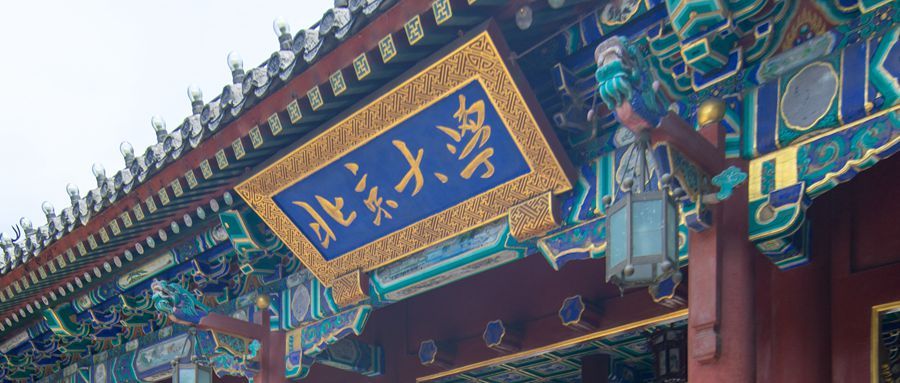
Picture source: Photo Network_501327454
With the results of the college entrance examination, the time of volunteer filling in various places has been entered.
The number of applicants for college entrance examinations in the country this year reached a record 11.93 million. According to the 92.89%of the admission rate of this special college last year, there will be a new stage of life in the threshold for tens of millions of candidates across the college entrance examination threshold. Which university to choose and which city is the "last level" in front of them.
A popular point of view believes: "You must choose a first -tier cities in college." Although this sentence is not necessarily completely accurate, it does reflect the variable of "city", which has become one of the important factors for the choice of tens of millions of candidates. After all, the educational resources and economic vitality of the city where the university is located is closely related to studying, employment and even life.
To this end, we try to provide a city selection guide from the dimensions of high education resources, population flow, development potential, etc.
Gather
First look at the degree of high education resources.
According to the latest data from the Ministry of Education, as of the end of May 2022, there were 2,759 ordinary colleges and universities across the country, of which 1270 undergraduate colleges and 1489 colleges of vocational (college) colleges.

In terms of geographical distribution, Beijing topped the list with 92 universities. Wuhan and Guangzhou followed closely. The number of universities was 83, which is the most collected place in the country's higher education resources. In addition, Chongqing, Zhengzhou, Shanghai, Xi'an, Chengdu, Tianjin, and Changsha are ranked 4-10th in the country, and the strength of high education resources cannot be underestimated.

Looking at undergraduate colleges alone, Beijing (67), Wuhan (46), Xi'an (44) ranked among the top three in the country, Shanghai (40), Guangzhou (37), Nanjing (34), Tianjin (31 ), Chengdu (29), Hangzhou (28), Harbin (27), Nanchang (27) and Changchun (27) are also at the forefront.
Of course, higher education resources depends not only on the quantity, but also the quality.
Earlier this year, the second batch of "double first -class" construction colleges and universities in the country was announced, and a total of 147 universities were shortlisted. Among them, there are 34 in Beijing, 15 and 13 in Shanghai and Nanjing, and there are 7 in Xi'an, Wuhan, Chengdu and Guangzhou.
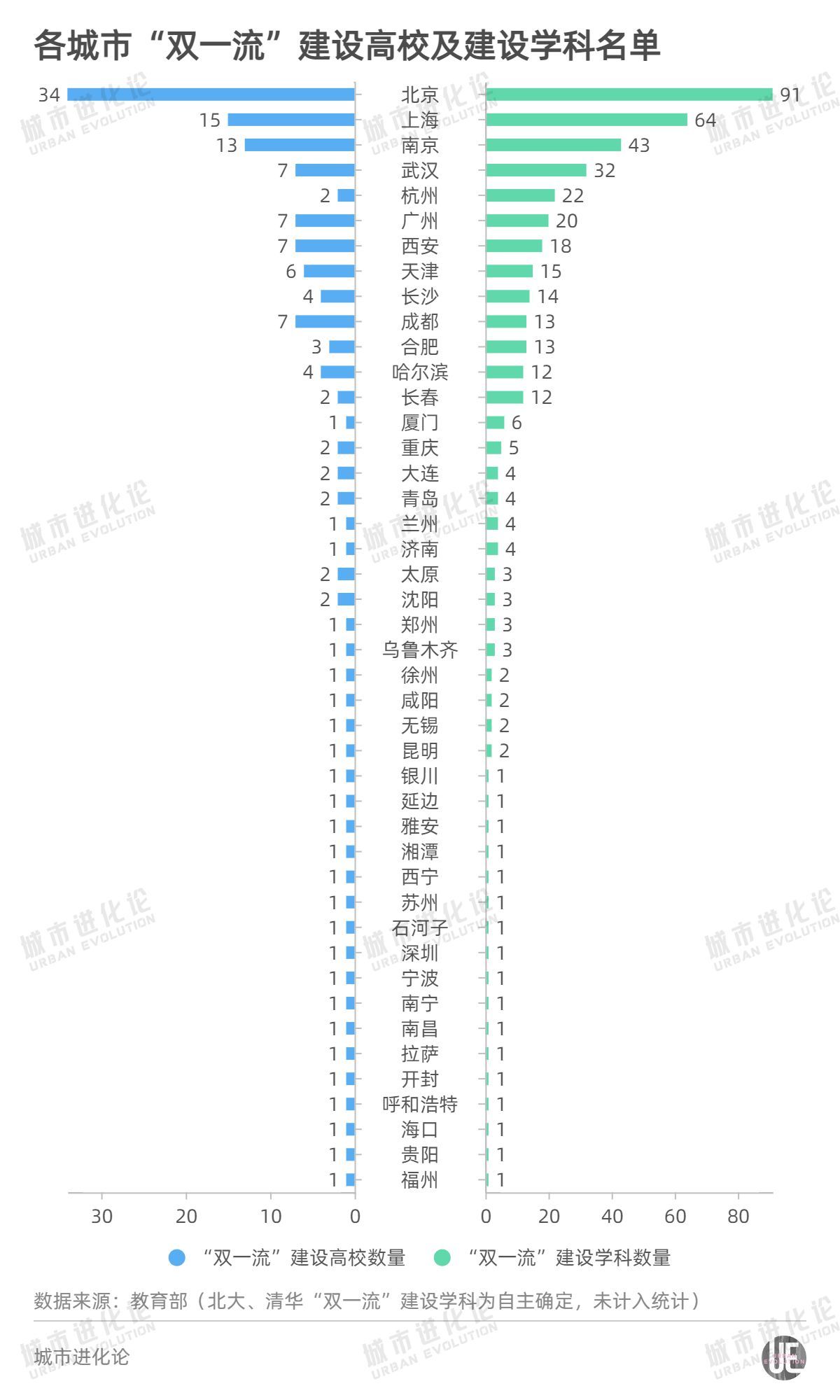
The above pattern basically shows the "plateau" and "peaks" of national higher education. It can be seen that there are no exceptions to be directly under the Central Government or provincial cities.
It is not difficult to understand that, as the provincial regional politics, economic, and cultural center, the provincial capital not only enjoy the dividends in the early days of higher education, but also provides a broader space for the development of colleges and universities.
In the past many years, the relationship between colleges and universities and cities has become popular, but overall, the distribution of higher education resources has not fully matched the strength of the city.
As a "special case" in first -tier cities, Shenzhen currently has a total of 8 and college -level universities, including 5 undergraduate colleges, which are still obvious compared to the other three first -tier cities. Even compared with the same types of cities such as Dalian, Qingdao, Xiamen and Ningbo, there is no advantage at all.
However, with its strong financial resources and industrial foundation, Shenzhen has "built universities crazy" in recent years, which not only has become the most established cities with "double first -class" universities, but also builds a "double first -class" construction of universities with "double first -class" universities.
Not only Shenzhen, Suzhou, Ningbo, and Wuxi have only one university in three economic cities, which are shortlisted for "double first -class", while Foshan, Nantong, Dongguan, Quanzhou and other GDP trillion cities are still zero.
In addition, in addition to the number and level of universities, the number of college students (graduate students) is also an important indicator for measuring the level of urban education.
In 2021, there were 7 cities with more than 100,000 graduate students nationwide (excluding Hong Kong, Macao and Taiwan), including Beijing (413,000), Shanghai (191,000), Wuhan (182,700), Nanjing (177,900), and, Nanjing (177,900), and Nanjing (177,900). Xi'an (164,400), Guangzhou (145,700) and Chengdu (1200,000).
The enrichment of urban high education resources means that there are more opportunities for choice, and can get more learning resources, and even facilitate schooling, employment and other aspects.
Flow
It is said that talents are the first resources of urban development. Gao education strong cities undoubtedly have the innate advantages that attract potential high -quality talents. However, there are not a few cities for "making wedding dresses for others". From the perspective of graduate flow, which cities are more competitive?
Let's take a look at which cities can retain their college students better.
The "Employment Report of the National College Graduates in 2021" released by the Wisdom Footprint of China Unicom shows that in terms of division, the scale of graduates in the east, China, West, and Northeast region in 2021 26%and 8%. Among them, the scale of graduates in the eastern region reached 3.65 million, and the Northeast region graduates were 720,000.
Looking at the city, Shenzhen is a typical "graduate harvester". The report shows that among the 36 key cities, Shenzhen key colleges and non -key colleges (staying in the city after graduation/studying in the city/study in the city) are all ranked among the top 75%. Although there were only 40,000 graduates in Shenzhen that year, it also reflected its strong attraction to local graduates.
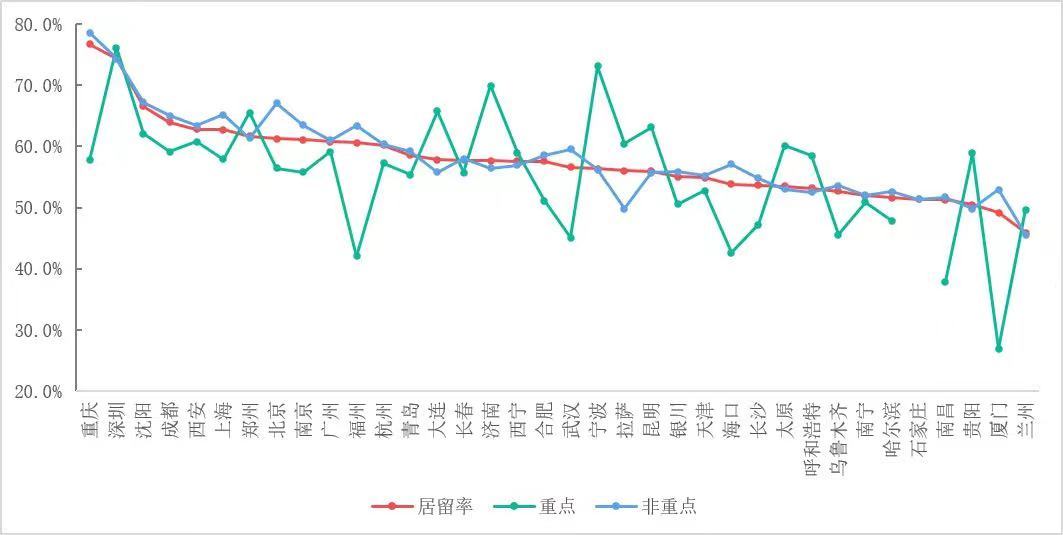
Source of 36 key cities in 2021
In contrast, the residence rates of graduates in Shanghai, Beijing, and Guangzhou were 62.7%, 61.3%, and 60.7%, respectively, ranking sixth, eighth, and ten, respectively. As a high education city, many graduates in Guangzhou have been "sucking" in Shenzhen. It is worth noting that the residence rate of graduates in Chongqing and Chengdu was 76.7%and 63.9%, respectively, ranking first and fourth. However, the common problems facing the two places are the poor residence rates in key institutions, only 57.7%and 59.1%, respectively, both outside the ten.
In addition, Shenyang (66.6%), Xi'an (62.8%), Zhengzhou (61.7%) and Nanjing (61.1%) have also ranked among the top ten. high.
2021 36 major cities fresh graduates' attraction four elephant limited pictures source: "2021 National College Graduate Employment Report"
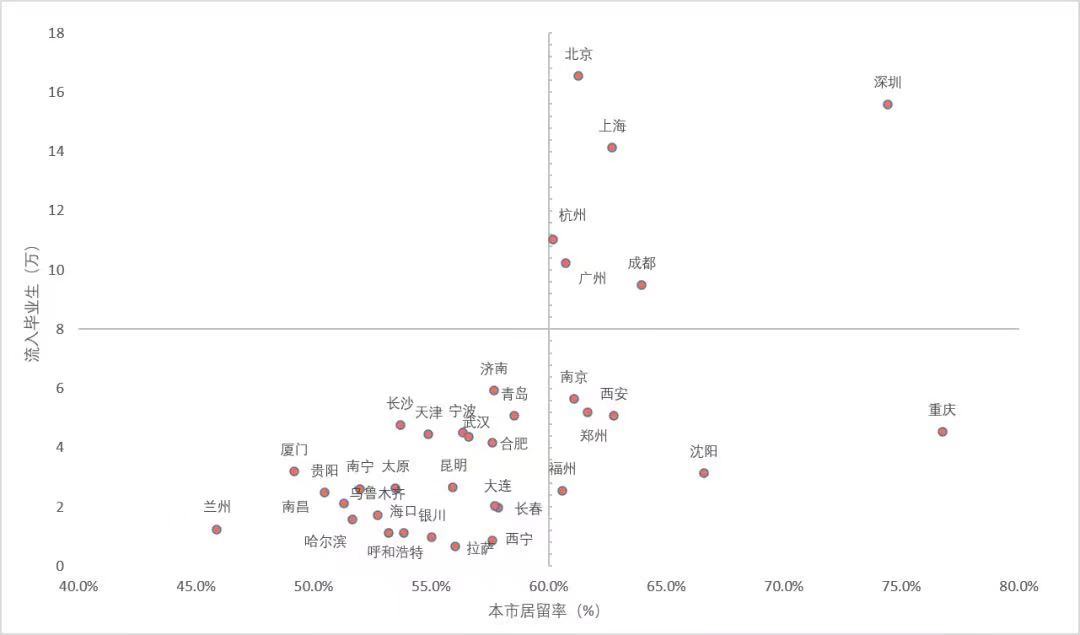
From another perspective, which places can attract college students to flow in?
The above report shows that among 31 provinces across the country, there are only 12 graduates' net inflows, and only 5 areas with more than 50,000 people. Graduates have become more and more obvious in the gathering effect of a few areas.
Source and proportion of 31 provinces in 2021: "Employment Report of National College Graduates in 2021"
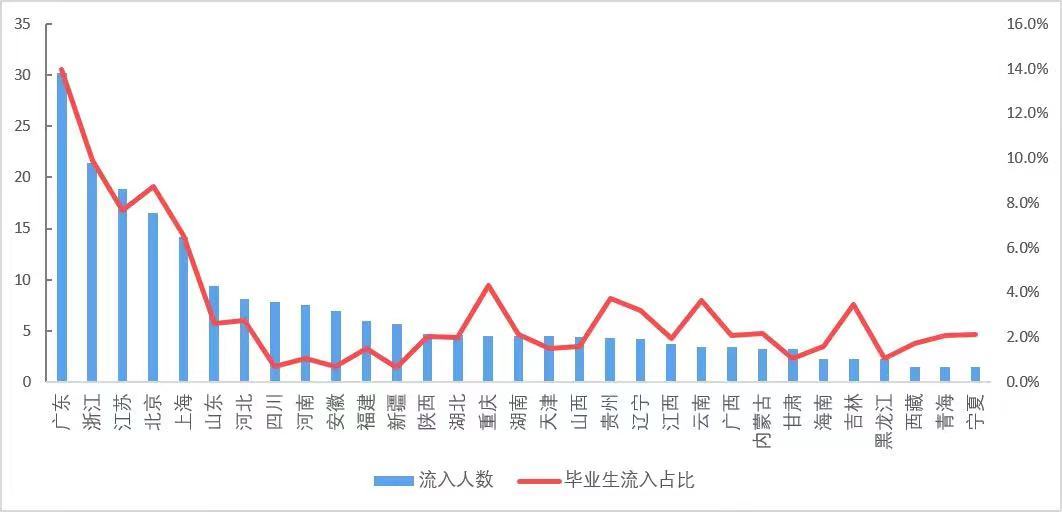
From the data point of view, Guangdong (302,000), Zhejiang (214,000), Jiangsu (189,000), Beijing (165,000) and Shanghai (141,000) contracted 47%of mobile graduates to form the first echelon; Shandong (Shandong (Shandong (Shandong ( 94,000), Hebei (81,000), and Sichuan (78,000) are the second echelon, which also attracted a large number of graduates.
If the time dimension is stretched further, the report shows that from 2019 to 2021, the scale and growth rate of graduates in Guangdong, Zhejiang, and Jiangsu ranks among the forefront of the country, an increase of 62,000, 58,000, and 23,000 respectively. The scale of graduates in the past three years of Hunan and Hubei provinces has declined year by year. Taking Changsha as an example, among the 79,000 graduates who did not live in the city in 2021, 24,000 people went to Guangdong Province for employment, with a proportion of 30%.
potential
The gathering of college graduates will inject more vitality into the development of the city; the rapid development of the city will also attract more college students to inflow. So, which cities are expected to become "potential stocks"?
Photo source: Photo Network_500698099
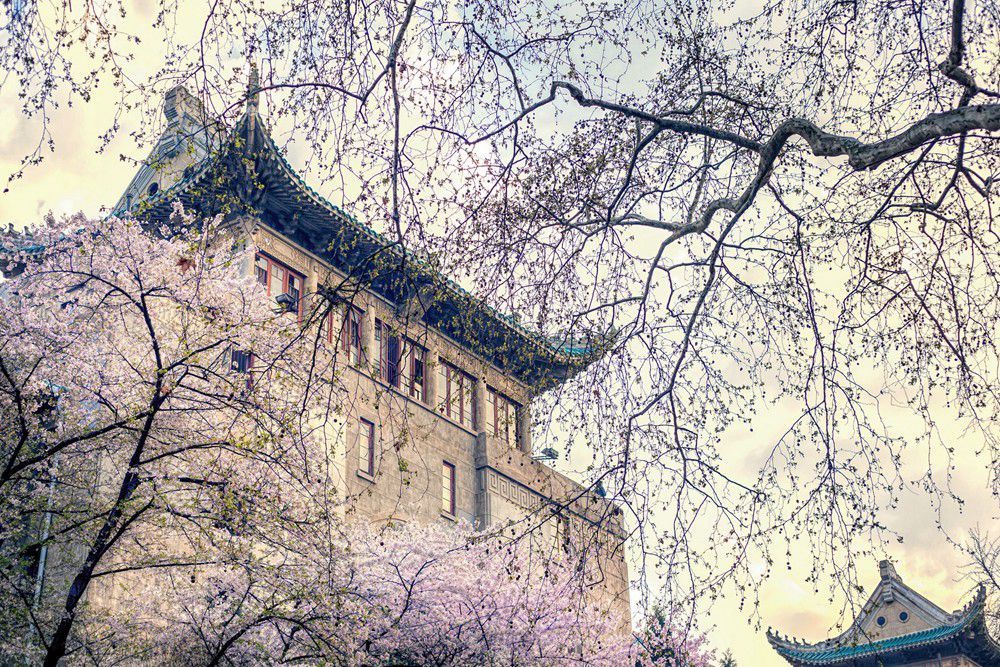
As a barometer of urban economic vitality, listed companies can be used as a very important observation window. Uncle Cheng has previously written in "Half of the Mountains in A shares" in "10 cities". As of the end of last year, there were 4685 A -share listed companies in the country, of which 46%were concentrated in Beijing, Shanghai, Shenzhen, Hangzhou, Suzhou, Suzhou, and Suzhou, and Suzhou, and Suzhou, and Suzhou, and Suzhou, and Suzhou,, Suzhou, Suzhou, and Suzhou, and Suzhou, Ten cities in Guangzhou, Ningbo, Nanjing, Wuxi, and Chengdu, and these 10 cities achieved the total number of listed companies in 2021 "breaking a hundred".
Among them, the number of listed companies in Beijing and Shanghai has crossed 400. In 2021, the number of new A -share listed companies in Shanghai, Shenzhen, Beijing, and Hangzhou was 48, 41, 40, and 37, respectively, becoming the most active leader in the capital market.
Behind this, it is obviously inseparable from the planning of cities on emerging industries and popular tracks, which will also largely affect the city's "urban transportation" to a large extent.
A typical example is Hefei. In recent years, the name "Most Best Drive City" on the top of the head, Hefei successively defended emerging industries such as Sino -Singapore Energy and integrated circuits, which has also made it the largest GDP increase in the past ten years. The rapid development of cities has also attracted talents.
"Our college has more than 170 graduates this year, of which 38 have gone to Hefei Changxin. Five years ago, after graduating from the college, we basically went to Jiangsu, Zhejiang, Shanghai or the Pearl River Delta." Li Shaozhang (pseudonym) told Uncle Cheng that as a leader in the field of domestic storage chips, the salary of Hefei Changxin was relatively strong. In addition, the surrounding talents introduced housing prices for less than 10,000 yuan/square meter. Very attractive.
In addition to the future industrial layout, with the advancement of urban agglomerations and urban areas, it will also greatly affect the city's prospects to a large extent.
For example, according to Zhilian's recruitment of the best employer of the year of the year in China, the Beijing -Tianjin -Hebei, the Yangtze River Delta, and the Guangdong -Hong Kong -Macao Greater Bay Area, as the three most active urban agglomerations in China's economy, are still the first choice for college talents. The development potential and lifestyle of the Shuangcheng Economic Circle in Chengyu area also attracted more and more young people, ranking fourth in attractiveness, becoming the new "dark horse".
In the final analysis, the city structure is not static, and a attractive city is related to multiple dimensions such as economic development, industrial structure, income level, business atmosphere, and urban culture. The core is a better life.
Daily Economic News
- END -
Joined forces!Jiangxi Daily signed a strategic cooperation agreement with Jiangxi University of Science and Technology
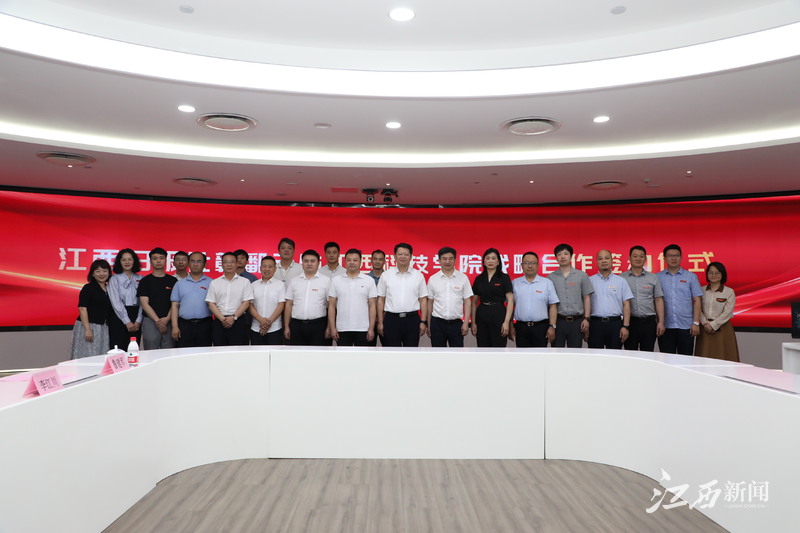
▲ Jiangxi Daily held a strategic cooperation signing ceremony with Jiangxi Univer...
"Law Scholars" magazine deputy editor -in -chief You Chenjun: The writing of law papers must have the relationship between "topic consciousness" and "problem awareness" and "topic consciousness"

Special writing | You ChenjunResponsible editor | Xue YingjunThere are 2257 words ...